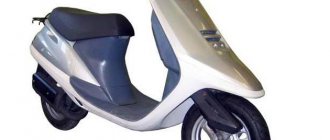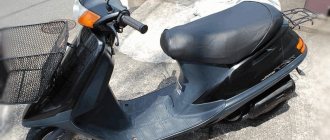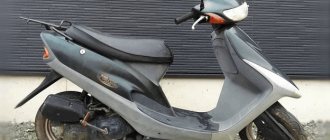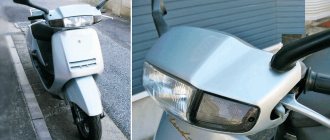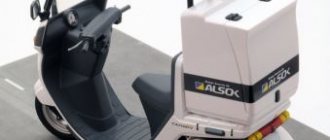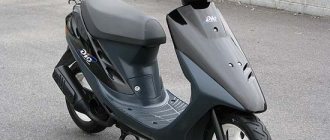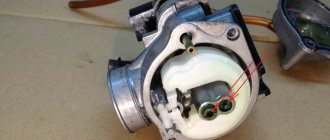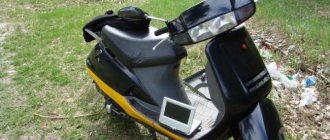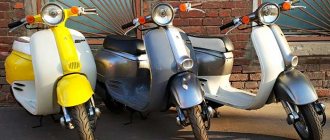The Honda Tact AF 51 scooter is rightfully recognized as one of the best scooters for mixed road surfaces and off-road use. Almost the entire Takt line is distinguished by maneuverability, unpretentiousness, and high load capacity. In this review we will talk about the crown of the entire series - Tact AF 51, produced in 1997-2002. Imagine: sometimes a Honda Tact AF 51 can be found even without mileage - they love the scooter so much. This model has absorbed all the best from its predecessors, becoming one of the most popular scooters. Engine with catalytic converter, anti-theft system, mixed brakes and much more in this review!
Appearance
The Honda Tact AF51 cannot be confused with any other scooter: rounded lines, a bright oval-shaped crystal headlight, a wide and long seat. In front of the driver’s feet there is a pocket in which hand luggage can be placed, and behind, traditionally, there is a trunk and rear panniers. At the edge of the rear of the body there are sharp turn signals running along the body and a rectangular headlight.
Scooter Honda Tact AF51 1998.
The two-seater scooter Takt AF51 with 50cc allows for a ride with a passenger, and you can ride really comfortably. It is worth noting its special design: it allows you to change your seating position while riding.
The dashboard traditionally houses the odometer, speedometer, fuel level sensor, as well as oil sensors, turn signals and the “Stand Up” system. The symbols on the panel are large; there are yellow arrows on the speedometer and fuel level sensor.
Dashboard Honda Tact AF 51
The Last Two-Stroke Tact
The Honda scooter under the factory designation AF-51 debuted in 1998 and almost became the last Tact in the company's history. The fact is that the outdated AF24E two-stroke engine no longer fit into the environmental framework, so the launch of the seventh generation of scooters was a big question.
Honda was not ready to replace the two-stroke two-stroke engine with a four-stroke engine in 1998, so it had to install the same old AF24E, but thoroughly redesigned to meet environmental standards, which reduced its power from 6.1 hp. up to 5.2 hp
Crystal and retro
The design of the tail of the seventh generation Honda Tact has changed thoroughly - now the bias towards retro style is clearly visible, where all the lines of the scooter have acquired smoothness and a certain massiveness. This is especially noticeable in the front end with a block headlight, massive wing and fairing.
The headlight, by the way, is crystal and has increased power (compared to the head light of the previous generation model).
Ride quality
The maximum speed of the Honda Tact AF-51 is electronically limited to 60 km/h. If you remove the limiter and catalyst, you can increase the maximum speed to 75 km/h, but if you drive at the limit, the engine will fail faster.
Thanks to the lever fork, the Honda Tact AF-51 is better suited for leisurely driving on bad roads.
Honda two-stroke engines have a separate lubrication system; it is installed on all generations of Tact, so there is no need to mix gasoline with oil yourself.
AF-51 Specifications
- engine type: two-stroke, forced air cooling, gas distribution by reed valve system;
- engine capacity: 50 cc cm;
- maximum power: 5.2-6.0 hp;
- length: 1655 mm;
- height: 1170 mm;
- front suspension type: wishbone;
- front brake type: disc;
- dry weight: 66 kg;
- fuel consumption: 2 l. / 100 km;
- maximum speed: 60 km/h.
Honda Tact AF-51 is an ideal budget segment scooter, simple and reliable. The only negative, and that is conditional, is the higher cost compared to models of previous generations, but the price/quality ratio is very good.
PS Of course, the next generation AF-75/79 with a four-stroke engine, produced since 2015, is newer and more modern than the AF-51, but the price category there is completely different.
In addition, the AF-51 and AF-75/79 models are not very different from each other in appearance (although, of course, the eighth generation looks a little more modern). But as for the four-stroke engine on the AF-75/79 model, it is frankly “vegetable”, especially in comparison with the AF24E on the Honda Tact AF30/31 model.
Tags
50 cc scooters
Technical characteristics of Honda Tact AF51
The scooter has an onboard fuel tank of 6 liters and an oil tank of 1.2 liters. The maximum speed is 60 km/h (electronically limited) can be increased with tuning. Disc brakes are installed at the front, drum brakes at the rear; this provides decent braking on different surfaces.
Dimensions Honda Tact AF51, length 1655 x width 625 x height 1020 mm.
Engine AF24E
The AF24E carburetor power unit with a forced air cooling system, which was installed on the Honda Tact AF 30/31, AF 52, has earned popularity among lovers of a smooth, high-torque and quiet ride. Engine volume – 49 cm3, power hp/rev. min – 5.2/6500. Gas distribution system - reed valves.
Transmission
CVT transmission with electric starter/kickstarter starting system. The front suspension is a pendulum lever fork, the rear suspension is a spring shock absorber. This combination allows you to move calmly both in urban and suburban conditions. The suspension absorbs all irregularities, leaving only pleasant impressions.
Maximum power Takt AF51 – 5.2 l/s at 6500 rpm. min.
Fuel consumption Honda Tact AF51
Claimed fuel consumption is 2 l/100 km. However, this indicator is difficult to achieve due to non-ideal conditions. Real fuel consumption on the Honda Tact AF51 is about 2.6 l/100 km in a mixed driving cycle.
- Engine – AF24E, 2-stroke, 1 cylinder;
- Power unit volume – 49 cm3;
- Cylinder diameter – 39.0 mm;
- Piston stroke – 41.4 mm;
- Compression ratio – 7.3;
- Power supply system – carburetor;
- Engine power, (hp/rpm) – 5.2/6500;
- Torque, (N*m/rpm) – 5.8/6000;
- Cooling – air;
- Fuel consumption – from 2 liters/100 km (up to 30 km/h);
- Maximum speed – 60 km/h;
- Gas tank volume – 6.0 liters;
- Oil tank – 1.2 liters;
- Front brake type – disc;
- Rear brake type: drum;
- Tire size, (front/rear) – 3.00-10 42J;
- Front suspension – pendulum wishbone fork;
- Rear suspension – shock absorber with spring assembly;
- Frame – steel pipe;
- Gearbox – variator (V-belt);
- Start type – kickstarter / electric starter;
- Scooter dimensions, (L x W x H) – 1655 x 625 x 1020 mm;
- Ground clearance – 100 mm;
- Seat height – 725 mm;
- Wheelbase – 1170 mm;
- The dry weight of the scooter is 66 kg.
Fuel consumption Honda Tact AF51 – 2 l. 100 km at a speed of 30 km/h.
Advantages and disadvantages
Advantages:
- High capacity.
- Combi Brake mixed braking system that evenly distributes braking forces.
- Comfortable and wide seat for two passengers.
- The pendulum lever fork at the front provides good cross-country ability on country roads.
- Availability of an anti-theft system (locking the central step in the trunk).
- Low-maintenance main components.
- Compactness.
Flaws:
- Low clearance in stock.
- Rolliness when cornering.
- Weak footrest bracket and other minor defects.
- Dynamics.
Secondary hit: Honda Tact AF-24
Honda Tact AF-24 is one of the most popular old Japanese scooters on the domestic market in the lower price segment. The fifth generation of Takts is the successor to the AF-16 and debuted in 1989.
In addition to minor external changes, the AF-24 received a completely new engine with the index AF24E, developing a power of 6 hp. Real fuel consumption with this engine is about 2.5 liters of gasoline per 100 km.
Design and ergonomics
The scooter has a classic design for Japanese models from the early 1990s. The plastic is of high quality, if the previous owner carefully operated the equipment, then even now it looks decent - because... not brittle and does not crack from weak impacts. Of course, the factory paint looks, in most cases, unattractive, but if you repaint the plastic, it will look like new.
The seat is supposedly a two-seater seat (this is only for Japanese and teenagers; adults of European build are unlikely to be able to fit on such a seat together). In Russia, such scooters are traditionally called 1½-seater.
There are quite spacious luggage compartments under the seat and front fairing.
Nuances of operation
The Honda Tact AF-24 has a lever fork, which is more suitable for poor roads in rural areas, where these scooters are mainly used. Of course, a traditional small-capacity scooter is generally not very suitable for rural areas, but the Tact feels better there than the Dio - that’s for sure.
If you increase the ground clearance by manipulating the fork and installing a rigid shock absorber, then you can even ride into the forest and fishing without any problems.
Pros and cons of the Tact AF-24
Like any technology, this model has its advantages and disadvantages... but there are still more advantages.
Strengths:
- simplest design, both in terms of reliability and repair and maintenance;
- spare parts are in stock and still available on order (many things are interchangeable from models of next generations);
- a very reliable and durable engine (with proper maintenance it can last 100,000 km without major repairs);
- the seat can accommodate two very slender
